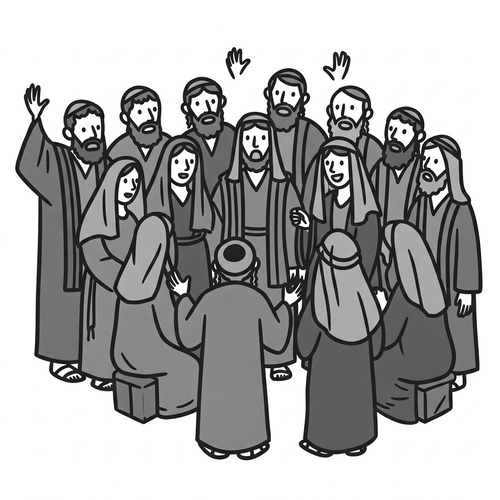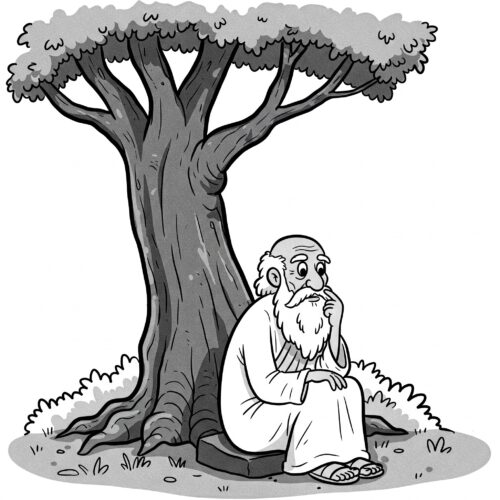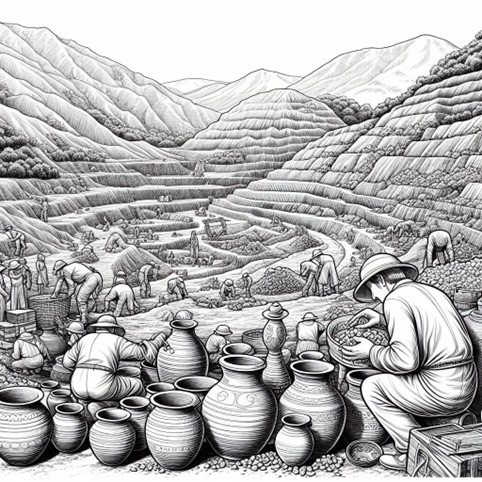Connecting the Dots: Coincidences Affirm Bible Reliability
What are Undesigned Coincidences (UCs)? Attentive readers often find delightful little details that seem to fit snugly together in the pages of Scripture, even when different writers report on the same events. Like puzzle pieces clicking perfectly into place, UCs convey a richer, more complete picture when combined than they do on their own. The beauty lies in their unintentional nature—the authors were clearly not coordinating or fabricating stories. Instead, these accidental alignments seem to emerge naturally, suggesting the writers were reporting real events without colluding with each other. The following UCs from the old and new testaments, are but a few of the numerous interconnected strands woven throughout Bible narratives, quietly testifying to the remarkable coherence arising from eyewitness accounts. Join us, as we explore how undesigned coincidences affirm Bible reliability…
How Coincidences in the OT Affirm Bible Reliability
The Battle Against the Amalekites
- Exodus 17:8-13 describes Israel’s battle with the Amalekites, highlighting the pivotal moment when Moses, Aaron, and Hur go to a hilltop to pray. As long as Moses keeps his hands raised, the Israelites prevail, showing the importance of divine intervention and of the leaders’ intercession during the battle.
- Deuteronomy 25:17-19 recounts the Amalekites’ attack on the Israelites when they were weary, providing context for the ongoing enmity between the two nations. This passage complements the Exodus account by explaining why the Amalekites are considered such a persistent threat, justifying the need for divine assistance in the battle described in Exodus.
Saul’s Death
- 1 Samuel 31:4-5 describes Saul’s final moments where he falls on his sword to avoid capture by the Philistines. This account emphasizes Saul’s desperation and the tragic end of his kingship.
- 2 Samuel 1:6-10 presents an Amalekite who reports Saul’s death to David, offering a different perspective that aligns with the earlier account by illustrating Saul’s desperation and vulnerability. The Amalekite’s story adds a layer of complexity and corroborates the dire situation Saul faced, enhancing our understanding of what really happened.
David’s Adultery with Bathsheba
- 2 Samuel 11:1-5 details David’s sin with Bathsheba, showing how he saw her bathing and committed adultery, leading to significant personal and political consequences. The passage sets the stage for the profound repercussions of David’s actions.
- 2 Samuel 12:9 features Nathan the prophet confronting David, referencing Uriah’s death and declaring the sword will never depart from David’s house. This confrontation directly ties in with the previous chapter, illustrating the fulfillment of the consequences of David’s sin as prophesied by Nathan.
The Census and Plague
- 2 Samuel 24:1-25 outlines David’s decision to take a census of Israel, followed by a devastating plague as punishment for his actions. The narrative highlights the severe consequences of David’s disobedience and his eventual repentance.
- 1 Chronicles 21:1-27 provides additional details, such as Satan inciting David to take the census and David’s sincere repentance. This account complements the Samuel narrative by offering deeper insight into the spiritual forces at work and David’s heartfelt response to the resulting calamity.
The Building of Solomon’s Temple
- 1 Kings 6:1-38 offers a detailed description of the construction of Solomon’s temple, including its dimensions, materials, and specific architectural features. This passage is crucial for us to understand the grandeur and significance of the temple in Israelite worship.
- 2 Chronicles 3:1-14 provides complementary information about the location and decorative elements of the temple, corroborating the account in 1 Kings. The Chronicles passage enhances the account of the temple’s construction by adding details about its aesthetic and sacred elements, confirming the meticulous effort that went into its creation.
How Coincidences in the NT Affirm Bible Reliability
Feeding of the 5,000
- John 6:5-7 describes Jesus asking Philip where to buy bread to feed the crowd. This passage raises the question of why Jesus specifically asked Philip.
- Luke 9:10 indicates that the event took place near Bethsaida, Philip’s hometown. This geographical detail explains why Jesus turned to Philip, as he would be familiar with the area, complementing John’s account and providing a natural reason for Jesus’ question.
Jesus’ Prediction of Peter’s Denial
- Matthew 26:34-35 recounts Jesus predicting that Peter will deny Him three times before the rooster crows. This sets the stage for Peter’s subsequent actions and his remorse.
- Mark 14:72 adds Peter heard the rooster crow twice, which provides an additional layer of detail to Matthew’s account. This specificity enhances the narrative by showing the exact fulfillment of Jesus’ prediction, reinforcing the reliability of the Gospel accounts.
The Women at the Tomb
- Matthew 28:1 mentions Mary Magdalene and the other Mary going to see the tomb after Jesus’ crucifixion. This introduction sets up the discovery of the empty tomb.
- John 20:1 focuses on Mary Magdalene going to the tomb and finding it empty, adding details about her initial reaction and subsequent encounter with Jesus. John’s account complements Matthew’s by confirming Mary Magdalene’s presence and offering additional context to the events at the tomb.
The Arrest of Jesus
- Matthew 26:51 describes one of Jesus’ companions cutting off the ear of the high priest’s servant during Jesus’ arrest. This act of violence is mentioned without identifying the attacker.
- John 18:10 identifies the companion as Peter and the servant as Malchus, providing specific names and details not mentioned in Matthew. This identification enriches the narrative by personalizing the individuals involved and aligning with the broader story of Peter’s impetuous nature.
Paul’s Journey to Corinth
- Acts 18:1-3 records Paul meeting Aquila and Priscilla in Corinth, noting that they were tentmakers by trade, like Paul. This detail establishes the context of Paul’s work and relationships in Corinth.
- 1 Corinthians 4:11-13 mentions Paul working with his hands, which aligns with his tentmaking activities mentioned in Acts. This consistency between Acts and 1 Corinthians provides a coherent picture of Paul’s life and ministry, demonstrating how his practical work supported his missionary efforts.
How Coincidences Between Scripture and Secular Writings Affirm Bible Reliability
Census During Quirinius’ Governorship
- Luke 2:1-3 mentions a census taken while Quirinius was governor of Syria, which necessitated Joseph and Mary’s journey to Bethlehem. This context sets the stage for Jesus’ birth in Bethlehem.
- Secular sources, such as the writings of Josephus, confirm Quirinius’ governorship and the practice of conducting censuses during his administration. This historical corroboration aligns with Luke’s account, reinforcing the reliability of the Gospel narrative.
Herod’s Death
- Matthew 2:19-20 describes an angel telling Joseph to return to Israel after Herod’s death, prompting the Holy Family’s return from Egypt. This passage highlights the end of a specific threat to Jesus’ life.
- Josephus’ writings provide detailed accounts of Herod’s death, including the political turmoil and subsequent changes in leadership. These secular records corroborate the timing and circumstances of Herod’s death, supporting the Gospel narrative and its historical accuracy.
Gallio’s Proconsulship
- Acts 18:12-17 mentions Paul being brought before Gallio in Corinth, where Gallio dismisses the charges against Paul. This event situates Paul’s ministry within a specific historical framework.
- The inscription at Delphi confirms Gallio’s proconsulship in Achaia around AD 51-52, precisely aligning with the timeframe mentioned in Acts. This archaeological evidence provides external validation for Luke’s account in Acts, demonstrating the historical reliability of the New Testament.
The Reign of Tiberius Caesar
- Luke 3:1 mentions the 15th year of Tiberius Caesar’s reign during John the Baptist’s ministry, establishing a chronological marker for the events described. This timeframe helps situate John’s and Jesus’ ministries within the broader historical context.
- Historical records corroborate the timing of Tiberius’ reign, confirming that the 15th year would be around AD 28-29. This external validation supports Luke’s chronology, enhancing the credibility of the Gospel’s historical claims.
Pontius Pilate’s Governorship
- The Gospels mention Pontius Pilate as the governor who presided over Jesus’ trial and authorized His crucifixion. Pilate’s role is critical to the Passion narrative.
- The Pilate Inscription, an archaeological find in Caesarea Maritima, confirms Pilate’s position as the prefect of Judea. This inscription supports the Gospel accounts, providing tangible evidence of Pilate’s historical existence and role, thereby affirming the New Testament’s reliability.
So, How do Coincidences Affirm Bible Reliability?
No ancient scripture can match the Bible’s intricate tapestry of undesigned coincidences, interwoven details that unite multiple independent accounts. The remarkable internal coherence, coupled with extensive external corroboration from history and archaeology, stands unparalleled among sacred texts. While all religious writings claim to convey transcendent truths, only the Judeo-Christian scriptures bear the unmistakable fingerprints of undesigned, mutually reinforcing realities recorded by genuine eyewitnesses.
This unique phenomenon allows the truth of the narrative to emerge with striking clarity, its carefully crosshatched strands of evidence powerfully validating the Bible’s divine inspiration and historical reliability. Like an intricate masterwork only the Master could envision, the undesigned coincidences permit us to connect the dots and behold the brilliant outlines of truth emerge before our eyes.
Related Reads:
- Papyri and Dead Sea Scrolls: Archaeology Endorses Scripture
- Historical Reliability of the Bible: Astonishing Archaeological Finds
- Canonicity: The Journey to the Bible We Know Today
- Unearthing the Past: Excavation Findings that Validate Bible Narratives
- Bible ‘Contradictions’: Hurdles to Faith? Not Quite
- Debunking Myths and Lies: The New Testament’s Enduring Reliability
Editor’s Pick

Did the Universe Have a Beginning? Why Science Says Yes
Did the universe have a beginning? Has the cosmos existed eternally or did it emerge at some finite point in [...]

Intelligent Design: Is It A God of the Gaps Argument?
The debate surrounding Intelligent Design (ID) and its place in science has sparked intense discussion in both scientific and theological [...]

Some Standing Here Will Not See Death: What Did Jesus Mean?
Jesus’ words leap off the page with startling immediacy: "Truly I tell you, some standing here will not taste death [...]

Multiple Spirit Outpourings in Acts: How Are These Significant?
MULTIPLE SPIRIT OUTPOURINGS IN ACTS: Ever wondered why the Book of Acts reports several dramatic outpourings of the Holy Spirit [...]

Failing the Math Test: Darwinism’s Wait Time Problem
In the grand narrative of origins, evolutionary theory has long been presented as an unassailable scientific truth. Textbooks, documentaries, and [...]

Blueprints of Life: Why Cellular Precision Demands a Designer
In the microscopic world of the cell, an intricate ballet unfolds every moment of every day. Molecules move with purpose, [...]
Too Perfect to Be Random: The Giraffe’s Remarkable Design
The giraffe is one of nature's most striking marvels—a creature whose distinctive features have captivated human imagination for centuries. Yet [...]
The Woodpecker’s Design: How Nature’s Headbanger Defies Evolution
Imagine a bird that slams its head against solid wood 20 times per second, enduring impacts of 1,200 G-forces—the force [...]
The Ear’s Intricate Design: Too Complex for Random Chance
The Ear's Intricate Design: When we listen to our favourite song, hear a loved one's voice, or notice the warning [...]
The Euthyphro Dilemma: Did God Invent Morality or Discover It?
A Biblical Creationist Answer to the 2400-Year-Old Question The Euthyphro Dilemma has challenged folks for over 2,400 years. First posed [...]









